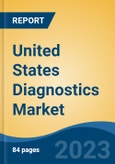Speak directly to the analyst to clarify any post sales queries you may have.
10% Free customizationThis report comes with 10% free customization, enabling you to add data that meets your specific business needs.
Recent developments in diagnostic technology, such as Roche's announcement in May 2025 to invest up to $550 million by 2030 in expanding its Indianapolis facility for continuous glucose monitoring, highlight the sector’s dynamic growth. This expansion not only enhances access to advanced diabetes care but also reflects broader trends in strengthening domestic diagnostic manufacturing capabilities. The increasing focus on early detection, chronic disease management, and patient accessibility continues to drive the rapid evolution and expansion of the diagnostics industry in the United States.
Key Market Drivers
Growing Burden of Infectious and Chronic Diseases
The rising incidence of infectious and chronic diseases in the United States is a major factor accelerating the demand for diagnostic testing. The COVID-19 pandemic highlighted the importance of swift and accurate diagnostics in controlling outbreaks. According to CDC data from May 2024, approximately 38 million Americans live with diabetes, and an additional 98 million are pre-diabetic, signaling the urgent need for early detection and intervention strategies. Moreover, with six in ten adults in the U.S. having at least one chronic disease - and four in ten having multiple conditions - the demand for regular monitoring and early diagnosis continues to grow. This persistent health burden is fostering the adoption of advanced diagnostic tools and driving the development of innovative technologies aimed at improving patient outcomes and reducing long-term healthcare costs.Key Market Challenges
Affordability for High-end Molecular Diagnostics
While molecular diagnostics offer advanced capabilities for disease detection, their traditionally high costs have limited access for many patients. Although prices are beginning to decline due to technological progress and market competition, this shift may lead to unintended consequences. Increased affordability could reduce demand for conventional diagnostic services as more people gain access to molecular diagnostics. This democratization of technology might also lead to oversupply and reduce per-capita utilization. As patients opt for direct and early testing, traditional diagnostic providers may face pressure to revise business models and remain competitive. While this trend may temporarily impact demand, it sets the stage for further innovation, shaping the future landscape of diagnostic services in the United States.Key Market Trends
Rising Development of Easy-To-Use Diagnostics Devices
The growing development of user-friendly diagnostic devices is transforming the way healthcare is delivered in the United States. These innovations empower individuals to conduct health tests from the convenience of their homes, reducing dependency on healthcare professionals for routine diagnostics. With real-time results and ease of use, these tools facilitate early detection and improved management of chronic diseases. They also reduce wait times and lower overall healthcare costs by promoting timely intervention. As the U.S. healthcare system continues to embrace accessible and patient-centered solutions, the adoption of these devices is expected to rise substantially. This shift supports a broader trend toward preventive care and greater patient engagement, ultimately improving public health outcomes.Key Market Players
- Abbott Laboratories, Inc.
- Danaher Corporation
- Thermo Fisher Scientific, Inc.
- Johnson & Johnson
- Ortho-Clinical Diagnostics, Inc.
- Becton, Dickinson, and Company
- Bio-Rad Laboratories, Inc.
- Roche Diagnostics Corporation
- Siemens Medical Solutions USA, Inc.
- Biomerieux Inc.
Report Scope:
In this report, the United States Diagnostics Market has been segmented into the following categories, in addition to the industry trends which have also been detailed below:United States Diagnostics Market, By Product Type:
- Reagents
- Instruments
- Software & Services
United States Diagnostics Market, By Type of Test:
- Infectious Disease Testing
- Lipid Panel
- Metabolic Panel
- Others
United States Diagnostics Market, By Technique:
- Immunodiagnostics
- Clinical Techniques
- Molecular Diagnostics
- Tissue Diagnostics
- Others
United States Diagnostics Market, By Usability:
- Reusable
- Disposable
United States Diagnostics Market, By Application:
- Infectious Diseases Cancer
- Sexually Transmitted Diseases
- Others
United States Diagnostics Market, By End User:
- Hospitals
- Public labs
- Diagnostic Centers
- Point-of-Care Testing Centers
- Private or Commercial Laboratories
- Others
United States Diagnostics Market, By Region:
- Northeast Region
- Mid-West Region
- West Region
- South Region
Competitive Landscape
Company Profiles: Detailed analysis of the major companies present in the United States Diagnostics Market.Available Customizations:
With the given market data, the publisher offers customizations according to a company's specific needs. The following customization options are available for the report.Company Information
- Detailed analysis and profiling of additional market players (up to five).
This product will be delivered within 1-3 business days.
Table of Contents
Companies Mentioned
- Abbott Laboratories, Inc.
- Danaher Corporation
- Thermo Fisher Scientific, Inc.
- Johnson & Johnson
- Ortho-Clinical Diagnostics, Inc.
- Becton, Dickinson, and Company
- Bio-Rad Laboratories, Inc.
- Roche Diagnostics Corporation
- Siemens Medical Solutions USA, Inc.
- Biomerieux Inc.
Table Information
| Report Attribute | Details |
|---|---|
| No. of Pages | 85 |
| Published | July 2025 |
| Forecast Period | 2024 - 2030 |
| Estimated Market Value ( USD | $ 35.66 Billion |
| Forecasted Market Value ( USD | $ 59.73 Billion |
| Compound Annual Growth Rate | 9.1% |
| Regions Covered | United States |
| No. of Companies Mentioned | 10 |









